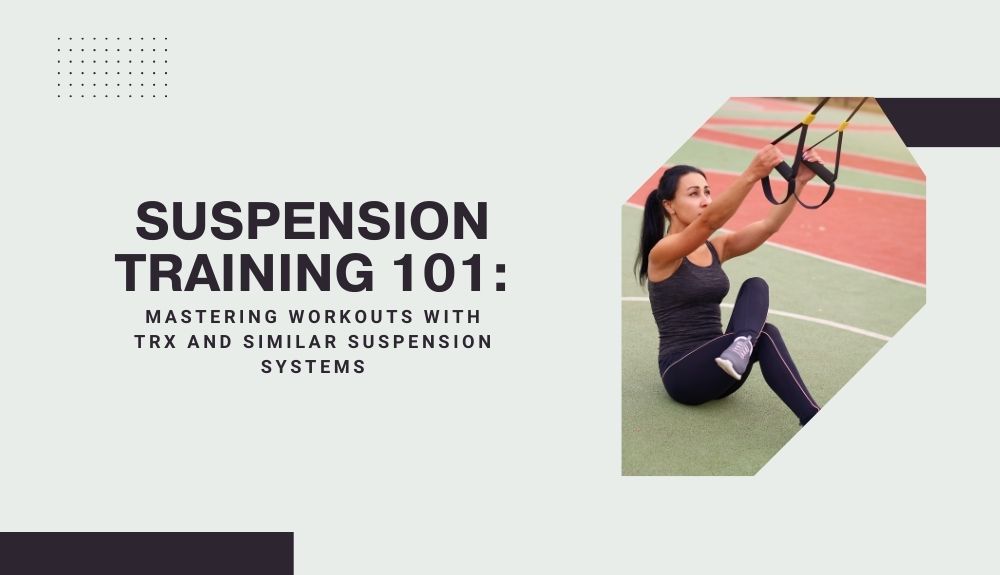Suspension training is like the secret weapon of fitness enthusiasts – versatile, challenging, and oh-so-effective. If you’ve ever seen those colorful straps hanging from a gym ceiling and wondered what all the hype is about, you’re in for a treat. In this blog post, we’ll dive into the world of suspension training, explore its benefits, master beginner to advanced exercises, and even learn how to set up your own system at home. Get ready to elevate your workouts to new heights with TRX and similar suspension systems!
Understanding Suspension Training
Suspension training is a form of bodyweight exercise that involves using straps or ropes suspended from an anchor point. The beauty of this workout method lies in its ability to engage multiple muscle groups simultaneously, providing a full-body challenge with every move.
By leveraging your own body weight and adjusting the angle and length of the straps, you can increase or decrease the intensity of each exercise. This means that suspension training is suitable for individuals of all fitness levels, from beginners to seasoned athletes.
One key aspect to grasp when it comes to suspension training is the concept of instability. Unlike traditional weightlifting where movements are controlled and predictable, suspension exercises require you to stabilize your body throughout each motion, engaging your core muscles and improving balance and coordination.
Whether you’re looking to build strength, improve flexibility, or enhance overall athleticism, understanding how suspension training works will set you up for success as you explore different exercises and routines in your fitness journey.
Benefits of Suspension Training
Suspension training offers a wide range of benefits that can take your workouts to the next level. One major advantage is the engagement of multiple muscle groups simultaneously, promoting overall strength and stability. This type of training also improves core strength, as every exercise requires constant stabilization.
Additionally, suspension systems allow for adjustable resistance levels by simply changing body positioning or angle. This versatility makes it suitable for all fitness levels, from beginners to seasoned athletes looking for a new challenge. Suspension training not only builds functional strength but also helps improve balance and flexibility.
Moreover, incorporating suspension exercises into your routine can enhance proprioception and coordination by challenging your body in different planes of motion. The instability provided by suspension systems forces you to engage smaller stabilizing muscles that may be neglected during traditional weightlifting routines.
Types of Suspension Systems (TRX, Jungle Gym, etc.)
When it comes to suspension training, there are various types of systems available to cater to different preferences and needs. One popular choice is the TRX system, known for its adjustable straps and versatile exercises that target multiple muscle groups simultaneously. The Jungle Gym suspension system offers a similar workout experience, with its durable design and ability to support various body weights.
Other options include the Monkii Bars, which provide a portable solution for on-the-go workouts, perfect for travelers or outdoor enthusiasts. The WOSS Attack Trainer is another reliable choice, offering stability and durability for intense workouts.
Each suspension system has its unique features and benefits, so it’s essential to choose one that aligns with your fitness goals and lifestyle. Experimenting with different systems can help you discover new ways to challenge your body and keep your workouts exciting.
How to Set Up a Suspension System at Home

Setting up a suspension system at home is easier than you think. Start by finding a sturdy anchor point like a door frame, ceiling beam, or even a tree branch outside. Make sure it can support your weight and the movements during your workout.
Next, adjust the straps to the desired length based on the exercise you’re planning to do. Most suspension systems come with easy-to-use buckles or clasps for quick adjustments.
Ensure that both straps are equal in length to maintain balance and stability during your workouts. This will help prevent any imbalances and potential injuries while exercising.
Once everything is set up properly, give it a test run before diving into your full workout routine. Check for any wobbling or instability in the system to avoid accidents later on.
With these simple steps, you’ll be ready to enjoy effective full-body workouts from the comfort of your own home using a suspension training system!
Beginner Exercises for Full-Body Workouts
Are you new to suspension training and looking to kickstart your fitness journey with full-body workouts? Perfect! Let’s dive into some beginner exercises that will help you build strength, stability, and endurance using TRX or a similar suspension system.
Start by mastering the basics with simple movements like squats, lunges, and rows. These foundational exercises target major muscle groups while improving core stability. Remember to maintain proper form throughout each movement to maximize effectiveness.
Transition into more challenging exercises as you gain confidence and strength. Try incorporating planks, push-ups, and mountain climbers into your routine. These dynamic moves engage multiple muscles simultaneously for a comprehensive workout experience.
Experiment with adjusting the straps’ length to modify the intensity of each exercise based on your fitness level. Focus on controlled movements and engaging your core for added stability during suspended exercises.
By incorporating these beginner-friendly full-body workouts into your routine, you’ll lay a solid foundation for progress in your suspension training journey. Keep pushing yourself out of your comfort zone and embrace the challenge ahead!
Advanced Exercises for Increased Challenge
Ready to take your suspension training to the next level? Advanced exercises offer increased challenges that will push your strength, stability, and endurance to new heights.
Try incorporating unilateral movements like single-leg squats or one-arm push-ups to engage more core muscles and improve balance. These exercises require extra control and focus as you work each side of your body independently.
For a full-body burn, experiment with explosive movements such as plyometric jumps or power pull-ups. These dynamic exercises not only boost cardiovascular fitness but also enhance overall athleticism through quick bursts of energy.
To target specific muscle groups with precision, explore isometric holds like the plank or L-sit. Holding these positions for extended periods can help build muscular endurance while testing your mental toughness.
Remember, mastering advanced suspension exercises takes time and practice. Start slow, focus on proper form, and gradually increase intensity as you build strength and confidence in your abilities.
Combining Suspension Training with Other Workouts
Have you ever thought about taking your workouts to the next level by incorporating suspension training with other forms of exercise? Combining suspension training with traditional weightlifting, cardio, or yoga can add a new dimension to your fitness routine.
For example, you can integrate TRX exercises into a HIIT (High-Intensity Interval Training) session for a killer full-body workout. By alternating between high-intensity exercises on the suspension system and bodyweight movements, you can boost your metabolism and burn more calories in less time.
If you’re into yoga or pilates, using a suspension system can help improve balance, flexibility, and core strength. Poses like planks or lunges become more challenging when performed using straps instead of stable ground.
Incorporating resistance bands or dumbbells along with suspension training can target specific muscle groups more effectively. For instance, combining bicep curls with TRX rows creates a comprehensive arm workout that engages both biceps and back muscles simultaneously.
By mixing up different types of workouts, you keep things exciting while continuously challenging your body in new ways. So why not experiment with fusion workouts that blend suspension training with other exercise modalities for maximum results?
Safety Tips and Precautions

When engaging in suspension training, safety should always be a top priority. To prevent injuries and make the most of your workouts, it’s essential to follow some key safety tips and precautions.
Ensure that the suspension system is securely anchored before starting your workout. Check for any signs of wear and tear on the equipment to avoid accidents during use.
Adjust the straps or handles to the appropriate length for each exercise. This will help maintain proper form and reduce the risk of straining your muscles.
Moreover, listen to your body during workouts – if you experience any pain or discomfort, stop immediately. Pushing through could lead to injury.
Additionally, start with basic exercises before progressing to more advanced ones. Building a strong foundation is crucial for avoiding overexertion.
Always warm up before starting your suspension training routine and remember to cool down afterwards. Proper preparation and recovery are vital components of a safe workout session.
ConclusionSuspension training is a versatile and effective way to take your workouts to the next level. Whether you are a beginner looking to improve your strength and stability or an advanced fitness enthusiast seeking new challenges, suspension systems like TRX offer endless possibilities for full-body exercises.
By understanding the basics of suspension training, setting up your system at home, and mastering both beginner and advanced exercises, you can achieve incredible results in terms of strength, endurance, flexibility, and overall fitness.
Remember to always prioritize safety by ensuring proper form during each exercise and adjusting the straps according to your skill level. Combining suspension training with other workout routines can help you target different muscle groups and keep your workouts varied and exciting.
So grab hold of those straps, challenge yourself with some gravity-defying moves, and elevate your fitness game with suspension training!





















